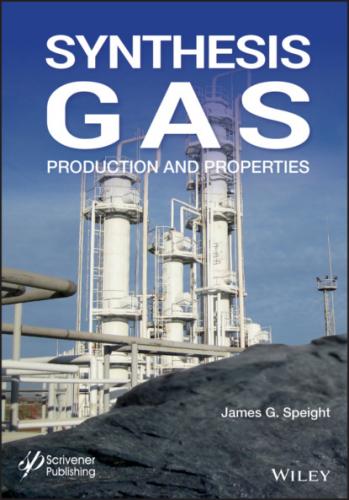Synthesis Gas. James G. Speight
* The use of heptane as the precipitant yields an asphaltene fraction that is different from the pentane-insoluble material as exemplified by differences in the elemental analysis. For example, the H/C ratio of the heptane-asphaltene fraction is lower than the H/C ratio of the pentane asphaltene fraction, indicating a higher degree of aromaticity in the heptane asphaltene fraction. The N/C, O/C, and S/C atomic ratios are usually higher in the heptane asphaltene fraction, indicating higher proportions of the heteroelements in this material. Nevertheless, each fraction is suitable for use as a feedstock for a gasification process.
The benefits of the addition of a gasification system in a refinery to process crude oil coke or other residuals include: (i) production of power, steam, oxygen and nitrogen for refinery use or sale, (ii) source of synthesis gas for hydrogen to be used in refinery operations as well as for the production of low-boiling refinery products through Fischer-Tropsch synthesis, (iii) increased efficiency of power generation, improved air emissions, and reduced waste stream versus combustion of crude oil coke or residues or incineration, (iv) no off-site transportation or storage for crude oil coke or residuals, and (v) the potential to dispose of waste streams including hazardous materials.
Gasification can provide high-purity hydrogen for a variety of uses within the refinery (Speight, 2014a, 2017). Hydrogen is used in refineries to remove sulfur, nitrogen, and other impurities from intermediate to finished product streams and in hydrocracking operations for the conversion of high-boiling distillates and oils into low-boiling products, naphtha, kerosene, and diesel fuel. Hydrocracking and severe hydrotreating require hydrogen which is at least 99% v/v, while less severe hydrotreating can work with gas streams containing 90% v/v pure hydrogen.
Electric power and high-pressure steam can be generated via gasification of crude oil coke and residuals to drive mostly small and intermittent loads such as compressors, blowers, and pumps. Steam can also be used for process heating, steam tracing, partial pressure reduction in fractionation systems, and stripping low-boiling components to stabilize process streams.
Carbon soot is produced during gasification – briefly, soot is a mass of impure carbon particles resulting from the incomplete combustion of hydrocarbons and is more typically a product of the gas-phase combustion process. The soot is transferred to the feedstock by contacting, in sequence, the quench water blowdown with naphtha, and then the naph-tha-soot slurry with a fraction of the feed. The soot mixed with the feed is finally recycled into the gasifier, thus achieving 100% w/w conversion of carbon to gas.
2.3.3 Refinery Coke
Coke is the residue left by the destructive distillation (thermal cracking) of crude oil residua. That formed in catalytic cracking operations is usually non-recoverable, as it is often irreversibly adsorbed on to the catalyst and is employed as fuel for the process when it is burned from the catalyst. The composition of crude oil coke varies with the source of the crude oil, but in general, large amounts of high-molecular-weight complex hydrocarbon derivatives (rich in carbon but correspondingly poor in hydrogen) make up a high proportion. The solubility of crude oil coke in carbon disulfide has been reported to be as high as 50 to 80%, but this is in fact a misnomer, since the coke is the insoluble, honeycomb material that is the end product of thermal processes.
Crude oil coke is employed for a number of purposes, but its chief use is in the manufacture of carbon electrodes for aluminum refining, which requires a high-purity carbon – low in ash and sulfur free; the volatile matter must be removed by calcining. In addition to its use as a metallurgical reducing agent, crude oil coke is employed in the manufacture of carbon brushes, silicon carbide abrasives, and structural carbon (e.g., pipes and Rashig rings), as well as calcium carbide manufacture from which acetylene is produced:
However, with the progressive increase in the amount of coke produced from the heavier (more viscous) refinery feedstocks, there is a renewed interest in the utilization of coke as a feedstock for a gasification process. This is one of the attractive options and is gaining increasing attention to convert the petcoke to value‐added products. The process offers the refiners a variety of product slates mainly via the production of synthesis gas. The products include steam, hydrogen, electricity, chemicals (such as methanol, CH3OH, and ammonia, NH3), and liquid fuels by way of the Fischer-Tropsch synthesis (Murthy et al., 2013).
2.3.4 Coal
The best example of a carbonaceous feedstock for a gasification process is coal, which is often used as a gasification feedstock in a refinery provided suitable coal resources are within economic reach. In fact, as a result of the rapid increase in the use of coal from the 15th century onwards (Nef, 1957; Taylor and Singer, 1957; Speight, 2013) it is not surprising the concept of using coal to produce a flammable gas, especially the use of the water and hot coal (van Heek and Muhlen, 1991), became commonplace (Elton, 1958). However, there are four main types of coal (Table 2.4) and, for maximum process efficiency, the properties of each type of coal must be given due consideration before selection of the requisite gasification process parameters.
Table 2.4 The four main types (ranks) of coal*.
| Type/rank | Properties |
| Lignite Sub-bituminous coal | Sometimes called brown coal. |
| The youngest of the coal types, and has the lowest energy content. Contains between 25 and 35% w/w carbon. | |
| High moisture content coal. | |
| Typically burned in power plants for electrical production. | |
| Has a higher energy content than lignite. | |
| Contains between 35-45% w/w carbon. | |
| Bituminous coal |
